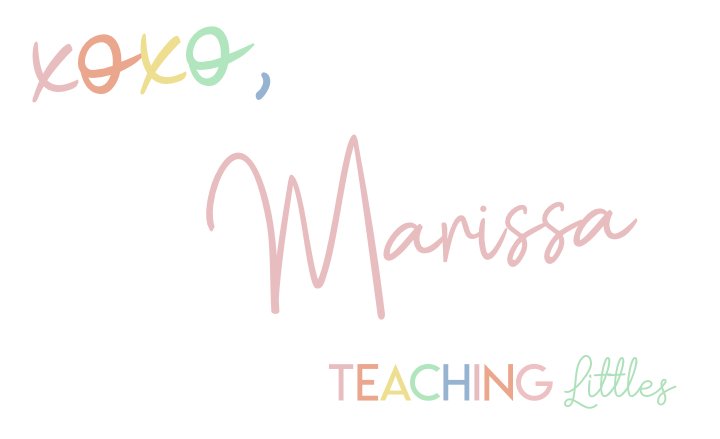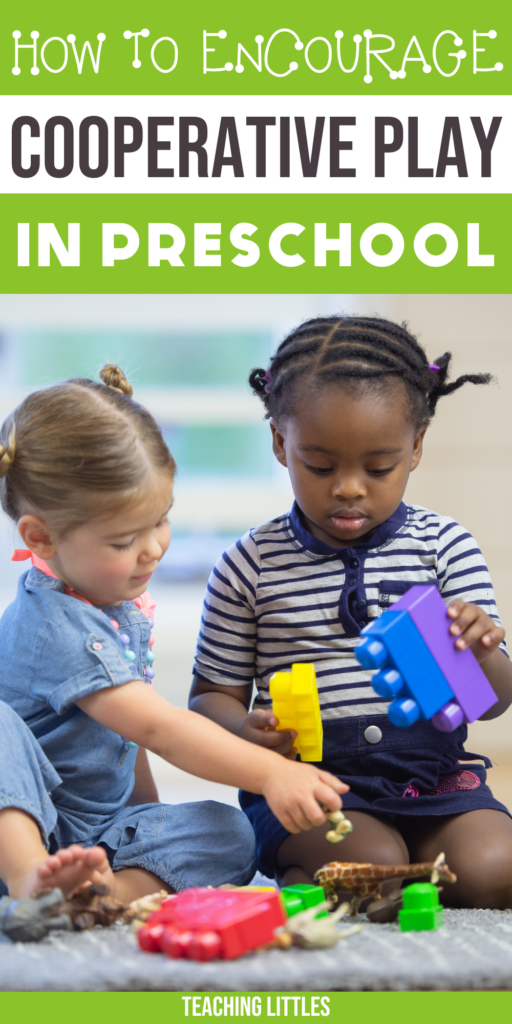Fostering cooperative play in preschool is important. As educators and caregivers, we witness firsthand the incredible benefits of children engaging in activities where they work together towards a common goal, learn empathy, and build friendships that last a lifetime.
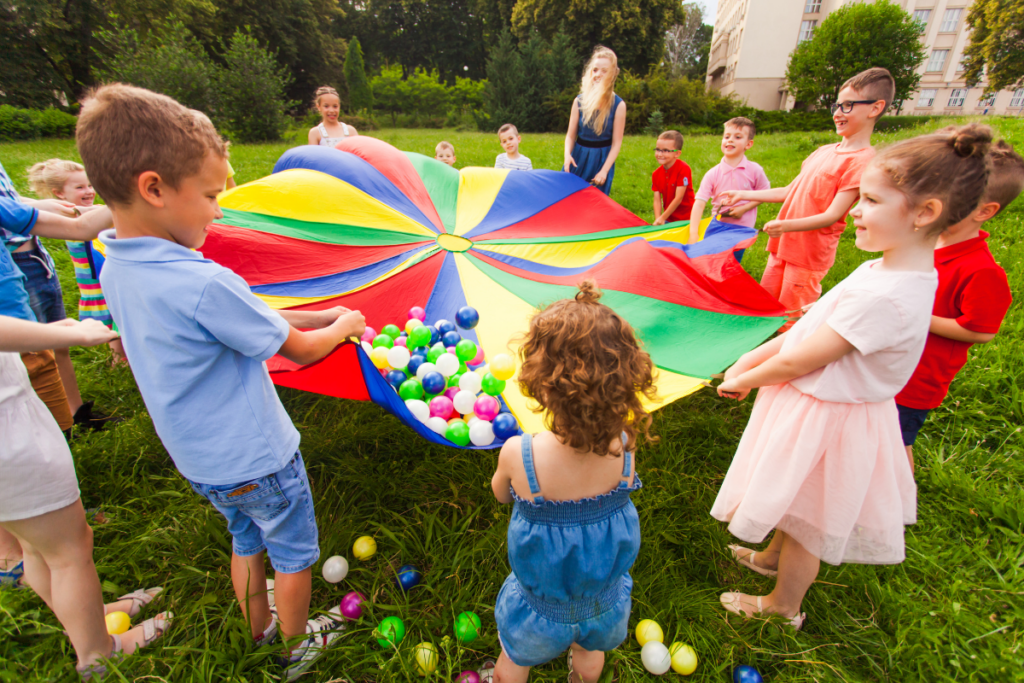
What is Cooperative Play?
Cooperative play is not just about sharing toys or taking turns (though those are important skills too!). It’s a beautiful dance of collaboration where children come together to achieve something beyond what they could do alone.
Whether it’s building a towering block castle, putting on a puppet show, or creating a vibrant mural, cooperative play encourages teamwork, communication, and creativity.
Why is Cooperative Play Important?
Beyond the joy and laughter, cooperative play lays a strong foundation for essential life skills. Through these experiences, children learn:
1. Communication: They practice expressing their ideas and listening to others. Whether it’s negotiating roles in a pretend game or deciding the next move in a building project, effective communication is key.
2. Problem-Solving: When faced with a challenge, like a block tower that keeps tumbling down, children learn to brainstorm solutions together. This fosters critical thinking and resilience.
3. Empathy and Respect: As they collaborate, children learn to consider others’ feelings and perspectives. They discover the joy of helping a friend and the importance of treating each other kindly.
4. Teamwork: Perhaps the most magical aspect of cooperative play is how it introduces the concept of teamwork from a young age. Children understand that when they work together, they can achieve something greater than what they could accomplish alone.
What are the Other Types of Play
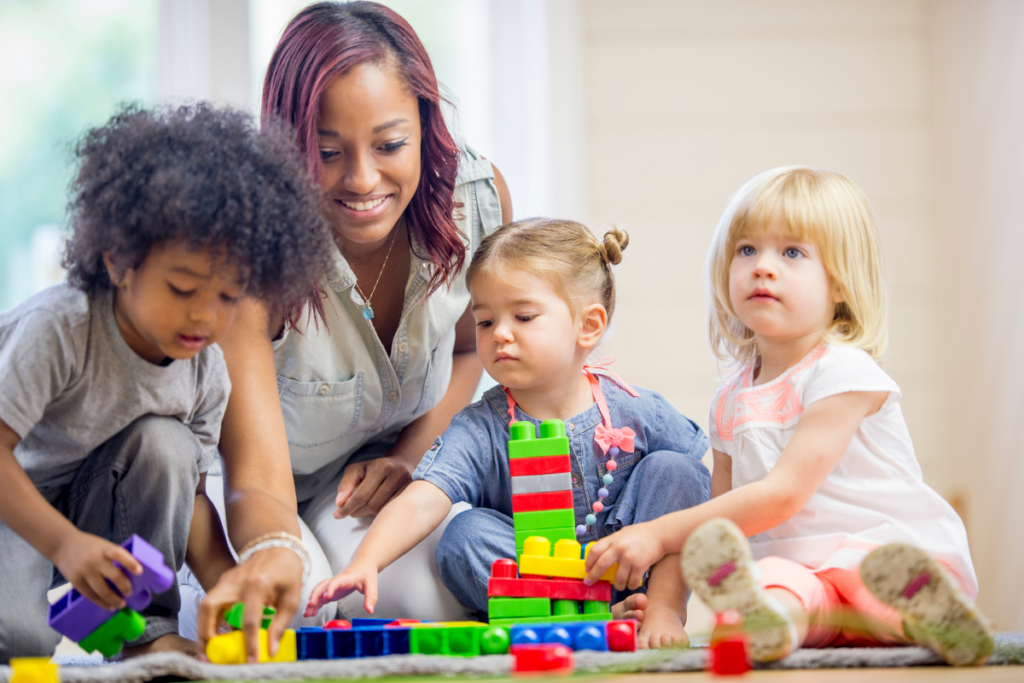
Play is a dynamic and evolving activity that changes as children grow and develop. Throughout childhood, children progress through different stages of play, each stage building upon the previous one and offering new opportunities for learning and social interaction. Here are the typical stages of play as identified by child development experts:
1. Unoccupied Play (0-6 Months):
- Description: During the earliest months of life, infants engage in unoccupied play, where they seem to move randomly and make simple movements without a specific goal.
- Characteristics: Babies may kick their legs, wave their arms, or make simple sounds without focusing on any particular object or activity.
- Purpose: This play stage helps infants explore their bodies and the world around them through basic movements and sensory experiences.
Related Post: 20 Ways to Play with a Newborn
2. Solitary Play (0-2 Years):
- Description: Solitary play is common among toddlers and young children, where they play alone and are absorbed in their own activities.
- Characteristics: Children engage in independent play with toys, books, or objects, without seeking interaction with others.
- Purpose: This stage allows children to explore and experiment with toys and materials at their own pace, fostering independence and creativity.
3. Onlooker Play (2-2.5 Years):
- Description: Onlooker play occurs when children observe others playing but do not actively join in the play.
- Characteristics: Children watch their peers play, often asking questions or making comments, but they do not directly participate.
- Purpose: This stage helps children learn by observing others’ actions and behaviors, laying the foundation for future social interactions.
4. Parallel Play (2.5-3 Years):
- Description: Parallel play involves children playing alongside each other with similar toys or activities, but they do not interact or share.
- Characteristics: Children may mimic each other’s actions, play side by side, and occasionally exchange toys, but they do not engage in joint activities.
- Purpose: This stage allows children to become more aware of their peers, practice basic social skills like sharing space, and develop comfort in the presence of others.
5. Associative Play (3-4 Years):
- Description: Associative play marks the beginning of more interactive social play, where children engage in similar activities together and begin to interact.
- Characteristics: Children may share toys, talk to each other, and show interest in what their peers are doing, but there is no structured or organized activity.
- Purpose: This stage fosters socialization, cooperation, and basic communication skills as children learn to play alongside others and share experiences.
Additional Notes:
- Symbolic Play: Throughout these stages, children also engage in symbolic play, where they use objects or actions to represent other things. This imaginative play helps with cognitive development and creativity.
- Age Ranges: While these stages are generally aligned with typical development, it’s essential to remember that children develop at their own pace. Some children may transition through the stages more quickly or spend more time in a particular stage before moving on to the next.
- Overlapping Stages: Children often engage in multiple stages of play simultaneously, especially during transitions. For example, a child may engage in parallel play with one friend while observing others’ activities (onlooker play) nearby.
When Should We Expect Cooperative Play?
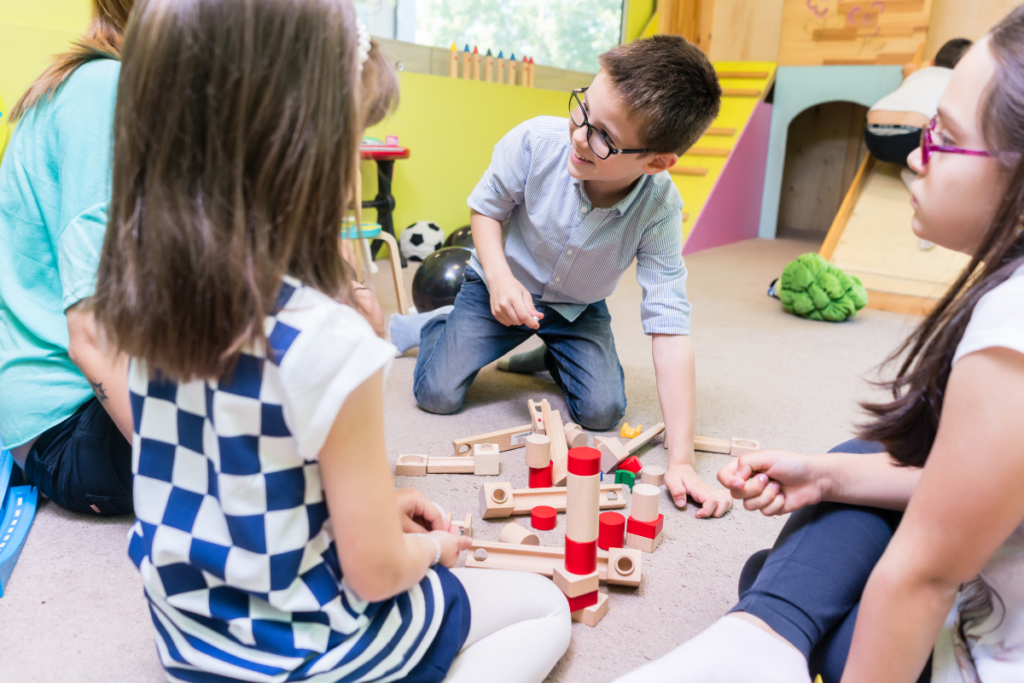
Cooperative play typically begins to emerge in children around the age of 4 and becomes more prevalent as they grow older. However, it’s important to remember that children develop at their own pace, so the timeline can vary from child to child. Here’s a general guideline for when to expect cooperative play to start:
Age 4-5:
- Emergence of Cooperative Play:
- Around the age of 4, children begin to show signs of cooperative play.
- They start to understand the concept of working together towards a shared goal.
- Simple cooperative activities, such as building a block tower together or playing a basic group game, become more common.
- Children may take on roles in pretend play scenarios, coordinating with others to act out scenes or stories.
Age 5-6:
- Development of Cooperative Skills:
- Between ages 5 and 6, children become more proficient in cooperative play.
- They engage in more complex collaborative activities, such as creating elaborate pretend worlds with friends.
- Communication and negotiation skills improve as they learn to express their ideas, listen to others, and compromise.
- Cooperative play becomes a regular part of their social interactions, both in structured activities and during free play.
Age 7 and Beyond:
- Mastery of Cooperative Play:
- By age 7, children typically have a solid foundation in cooperative play.
- They enjoy working together on projects, games, and group activities.
- Teamwork becomes more sophisticated as they learn to plan, problem-solve, and divide tasks among group members.
- Cooperative play continues to evolve, providing opportunities for children to develop leadership skills, empathy, and a sense of belonging within their peer groups.
Factors Influencing Cooperative Play:
- Social Environment: Children who have regular opportunities to interact with peers in group settings, such as preschool, playgroups, or organized activities, may develop cooperative play skills earlier.
- Parental/Caregiver Involvement: Parents and caregivers can support the development of cooperative play by modeling teamwork, encouraging social interactions, and providing opportunities for group play.
- Temperament and Personality: Some children naturally gravitate towards group activities and enjoy collaborating with others, while others may be more introverted or hesitant to engage in cooperative play initially.
- Cultural and Family Influences: Cultural norms and family dynamics can also play a role in how children approach social interactions and collaborative activities.
Related Posted: Benefits of Outdoor Play
Fostering Friendships and Belonging
In the world of preschool, friendships bloom like wildflowers during cooperative play. Shared experiences create bonds that go beyond just playtime.
When children work together towards a common goal, they develop a sense of belonging and connection within their peer group.
This feeling of camaraderie boosts their confidence, reduces feelings of loneliness, and creates a supportive environment where everyone is valued.
Tips for Encouraging Cooperative Play
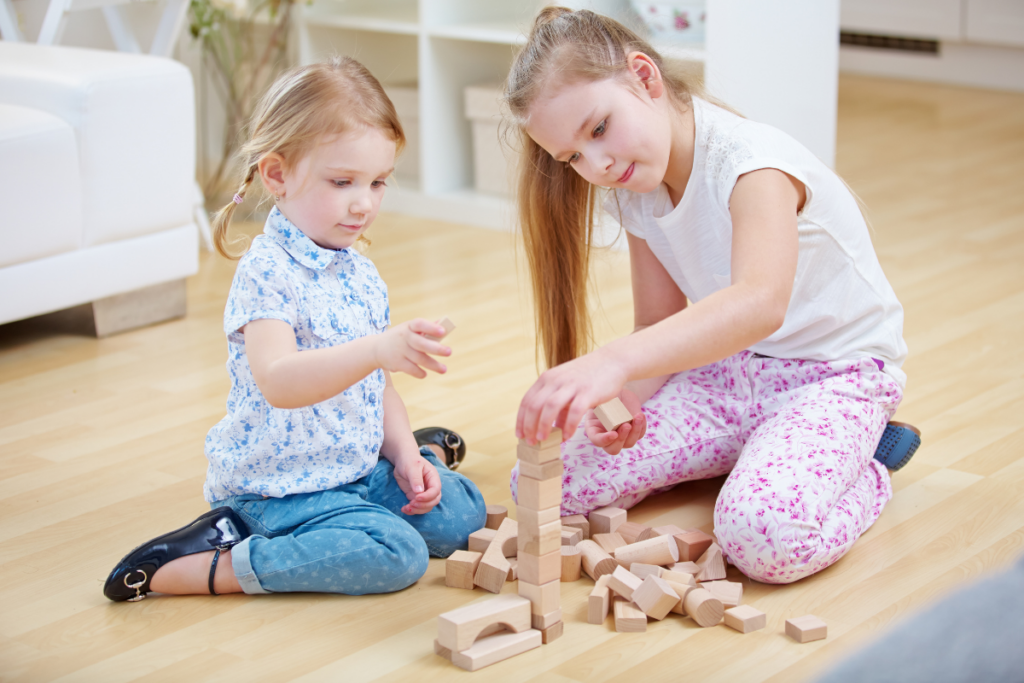
As educators and caregivers, we can nurture the magic of cooperative play:
1. Provide Opportunities: Set up activities that naturally lend themselves to collaboration, such as group art projects, building with blocks, or dramatic play scenarios.
2. Model Cooperation: Children learn by example. Show them how to take turns, share materials, and listen to each other respectfully.
3. Celebrate Teamwork: Praise efforts when you see children working together harmoniously. Acknowledge their communication skills, problem-solving abilities, and kindness towards each other.
4. Encourage Communication: Help children find their voices by asking open-ended questions. “How can we solve this puzzle together?” or “What do you think our castle needs next?”
5. Foster an Inclusive Environment: Ensure that all children feel welcome to join in. Encourage older children to guide younger ones, creating a sense of mentorship and inclusion.
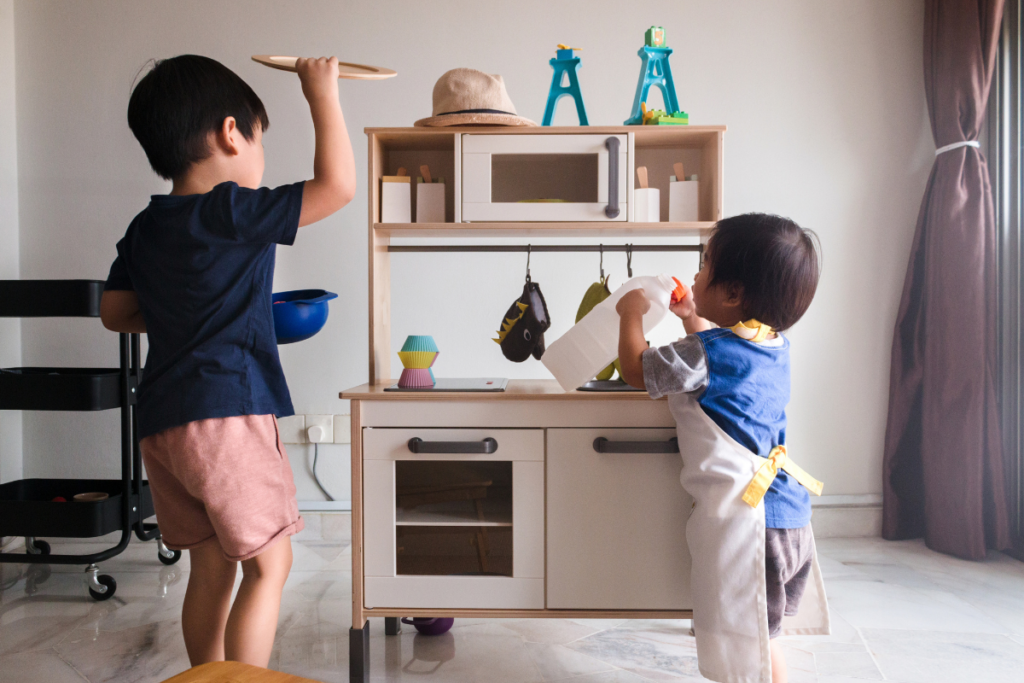
What Cooperative Play Isn’t
While cooperative play is a wonderful and enriching aspect of children’s development, it’s also essential to understand what it is not.
Here are some clarifications on what cooperative play isn’t:
1. Competitive Play:
- Description: Competitive play involves activities where the primary focus is on winning or outperforming others.
- Characteristics: Children may be pitted against each other, with a clear emphasis on being the best, scoring points, or achieving individual success.
- Example: Games with winners and losers, sports matches where the goal is to defeat opponents, or activities where one child’s success means another’s failure.
- Contrast: In cooperative play, the focus is on working together towards a common goal, rather than competing against each other. Success is shared, and the emphasis is on collaboration and teamwork.
2. Parallel Play:
- Description: Parallel play involves children playing alongside each other with similar toys or activities, but without interacting.
- Characteristics: Children may be engaged in their own play, absorbed in their activities, without any communication or collaboration.
- Example: Two children building separate block towers next to each other without sharing blocks or ideas.
- Contrast: Cooperative play, on the other hand, involves children actively working together towards a shared objective. It requires communication, teamwork, and coordination to achieve a common goal.
3. Bossy or Directive Play:
- Description: Bossy or directive play occurs when one child takes charge, dictates the play, and tells others what to do without considering their ideas or input.
- Characteristics: One child may dominate the play, assigning roles, making decisions, and not allowing others to contribute equally.
- Example: A child organizing a pretend game and telling others exactly how to play their roles without listening to suggestions.
- Contrast: In cooperative play, all children have a voice and contribute to the decision-making process. It involves mutual respect, active listening, and shared responsibilities.
4. Isolated Play within a Group:
- Description: Isolated play within a group occurs when children are physically together but engage in solitary activities without interacting or collaborating.
- Characteristics: Children may be in the same space but absorbed in their own world, showing little interest in what others are doing.
- Example: A group of children each playing with their own toys or activities in the same room without engaging with each other.
- Contrast: Cooperative play requires active engagement, communication, and shared participation towards a common goal. It involves interaction, collaboration, and a sense of unity among the children.
5. Chaotic or Unstructured Play:
- Description: Chaotic or unstructured play lacks clear organization, goals, or guidelines, leading to confusion and lack of direction.
- Characteristics: Children may engage in random activities without a clear purpose or plan, resulting in disorganized play.
- Example: A group of children running around aimlessly, grabbing toys without a specific goal or direction.
- Contrast: Cooperative play is structured and organized towards achieving a shared objective. It involves planning, communication, and coordination to work together effectively.
6. Exclusionary Play:
- Description: Exclusionary play occurs when children intentionally leave others out of the play, creating feelings of isolation and exclusion.
- Characteristics: Some children may be deliberately excluded from joining activities, games, or conversations.
- Example: A group of children forming a club and not allowing others to join or play with them.
- Contrast: Cooperative play promotes inclusivity, teamwork, and a sense of belonging for all participants. It involves welcoming others, sharing responsibilities, and valuing each person’s contributions.
Cooperative Play Ideas
1. Building a Giant Block Tower
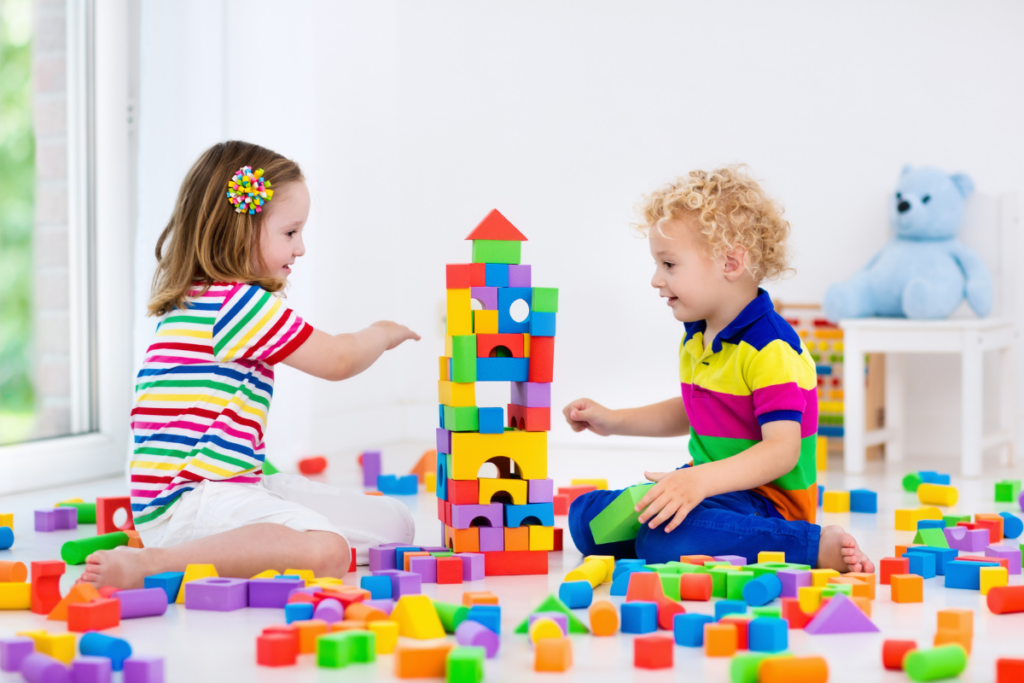
Materials Needed: Large blocks (such as cardboard boxes, wooden blocks, or foam blocks)
How to Play:
- Gather a group of children and a variety of large blocks.
- Challenge them to work together to build the tallest tower they can.
- Encourage communication as they discuss which blocks to use, how to balance them, and where to place each piece.
- Celebrate their teamwork as they create a masterpiece together!
2. Creating a Collaborative Art Mural
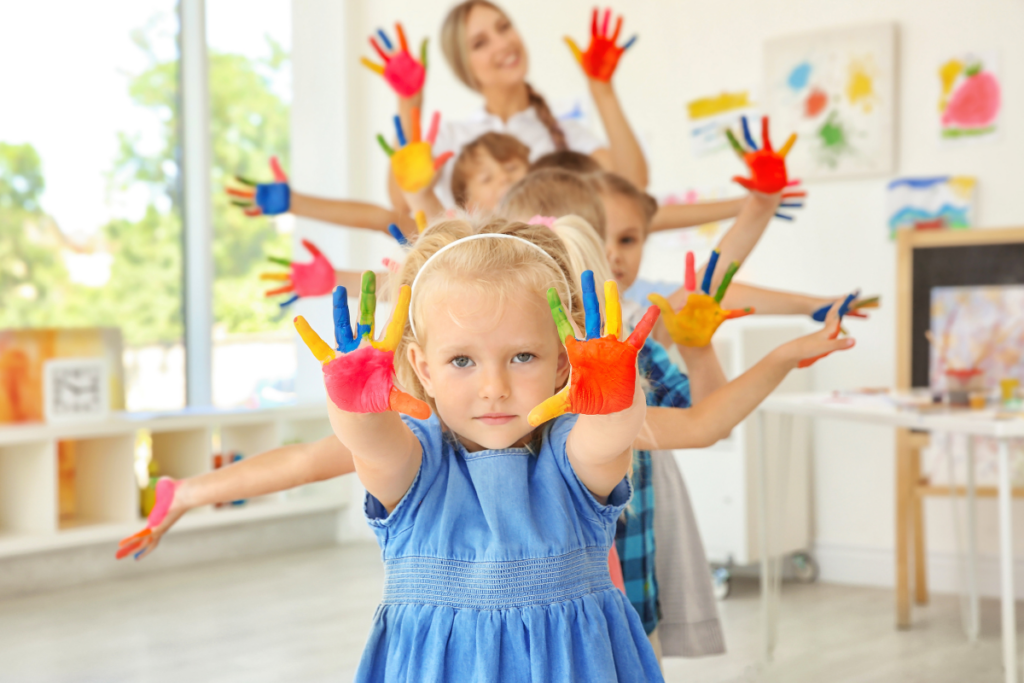
Materials Needed: Large piece of butcher paper or a canvas, paints, paintbrushes
How to Play:
- Lay out the large paper or canvas in a shared space.
- Invite children to work together on a mural, painting scenes from their favorite storybook or creating a unique masterpiece.
- Encourage them to take turns adding to the artwork, discussing ideas, and blending their styles.
- Display the finished mural proudly for all to see, showcasing their collaborative creativity.
3. Putting on a Puppet Show
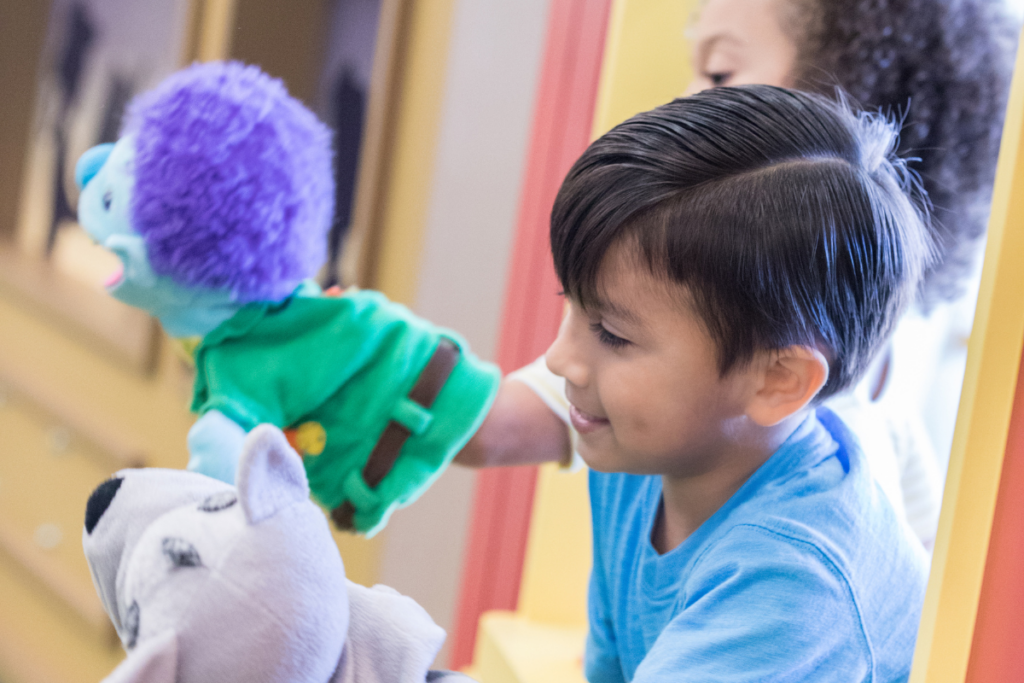
Materials Needed: Hand puppets, puppet theater (can be as simple as a table with a blanket draped over it)
How to Play:
- Provide a collection of hand puppets and a makeshift puppet theater.
- Encourage children to work together to create a puppet show, complete with a story, characters, and dialogue.
- They can take turns operating the puppets, narrating the story, and providing sound effects.
- Invite other children or adults to be the audience for their delightful performance!
4. Building a “Friendship Fort”
Materials Needed: Blankets, chairs, pillows, and any other fort-building materials
How to Play:
- Set out a variety of materials for building a fort, such as blankets, chairs, and pillows.
- Encourage children to collaborate on designing and building a cozy “Friendship Fort.”
- They can work together to decide on the layout, entrances, and decorations for their special hideaway.
- Once complete, the fort becomes a magical space for imaginative play, storytelling, and friendship bonding.
5. Cooperative Sensory Play: “Mixing Potions”

Materials Needed: Sensory bin or large container, water, various safe household items for mixing (e.g., spoons, cups, funnels), food coloring (optional)
How to Play:
- Fill a sensory bin or large container with water.
- Provide an array of safe items for mixing, such as spoons, cups, funnels, and containers of different sizes.
- Add a few drops of food coloring to make it more engaging (optional).
- Invite children to work together to create magical “potions” by mixing and stirring the water with various items.
- Encourage them to take turns adding ingredients, describing the potions they’re making, and imagining their magical effects.
6. Nature Scavenger Hunt Adventure:
- Materials Needed: Scavenger hunt list (printed or written), small baskets or bags, magnifying glasses (optional).
- How to Play:
- Create a list of nature items for children to find, such as a pinecone, a smooth rock, a feather, a flower, etc.
- Divide children into small teams and give each team a list and a basket.
- Teams work together to search for the items in a designated outdoor area, collaborating to check off each find.
- Encourage teamwork by having them help each other spot items, share discoveries, and strategize their search.
- Once all items are found, gather together to compare treasures and celebrate their nature adventure.
7. Music Band Jam Session:
- Materials Needed: Toy musical instruments (drums, shakers, tambourines, etc.), scarves or ribbons for dancing (optional).
- How to Play:
- Set up a “music corner” with a variety of instruments and props.
- Invite children to form their own music bands, assigning roles like drummers, guitarists, singers, and dancers.
- Encourage bands to collaborate on creating a musical piece, experimenting with rhythms, melodies, and movements.
- Children take turns performing their compositions for each other, cheering and supporting their fellow bandmates.
- This activity promotes teamwork, creativity, and a shared sense of rhythm and harmony.
These cooperative play ideas are not only fun and engaging but also provide rich opportunities for children to practice communication, teamwork, problem-solving, and creativity. So, gather the little ones, spark their imaginations, and watch as they create wonderful memories together through the magic of collaboration!
Cooperative Play Ideas to Try with Your Child
1. Play a Board Game
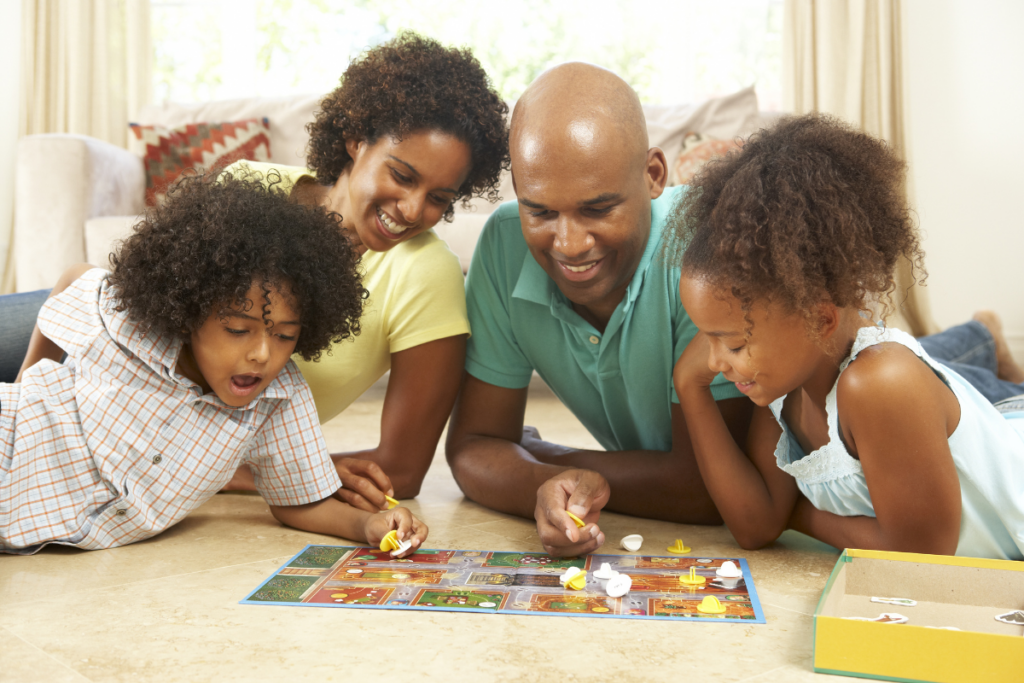
Playing board games with kids isn’t just about passing the time; it’s an excellent way for them to learn about rules and social interactions.
Tips for Cooperative Play:
- Rule Understanding: Listen attentively as the rules are explained, emphasizing the importance of following them throughout the game.
- Patience and Persistence: Encourage patience as your child navigates the challenge of adhering to rules, fostering perseverance and focus.
- Gentle Rule Reminders: If a rule is accidentally broken, gently remind your child of the rules and why they contribute to fair gameplay.
- Modeling Sportsmanship: Display good sportsmanship whether you win or lose, showing your child how to gracefully accept outcomes and respect opponents.
- Empathy Building: Losing gracefully helps your child understand the feelings of others, promoting empathy and consideration in social interactions.
- Celebrating Efforts: Offer praise and positive reinforcement for participation and effort, whether it’s a win or a learning experience.
- Stress Management Together: Practice stress management exercises if your child feels overwhelmed, teaching valuable emotional regulation skills.
2. Create a Dance Routine

For little dancers with boundless energy, choreographing a dance routine together can be a delightful and cooperative activity.
Dance Collaboration Tips:
- Imaginative Expression: Explore creative movements and steps, encouraging your child to express themselves freely.
- Listening and Negotiating: Work together to decide which moves to include, fostering negotiation skills and compromise.
- Patience in Practice: Practice patience as you learn and perfect the choreography together, celebrating progress along the way.
- Transferable Life Skills: The teamwork and creativity involved in dance routines translate into valuable skills for various aspects of your child’s life.
- Bonding Through Movement: Dancing together creates special moments of connection and shared creativity.
3. Finish a Puzzle
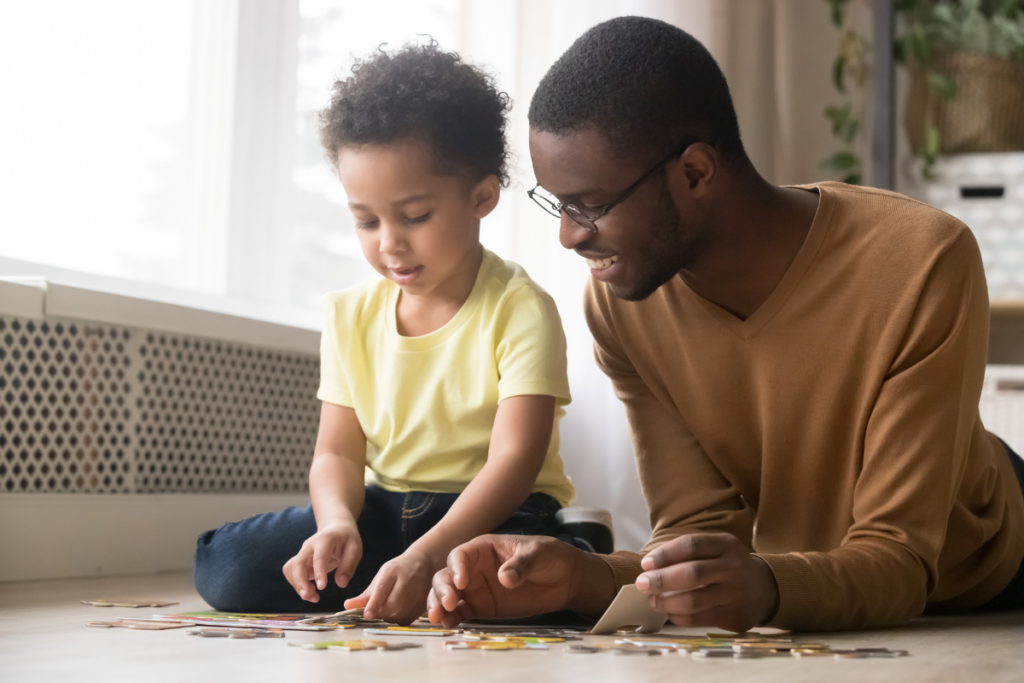
A puzzle-solving adventure isn’t just about fitting pieces together; it’s a cooperative journey of problem-solving and memory development.
Puzzle-Perfect Collaboration:
- Problem-Solving Exploration: Encourage your child to experiment with different pieces, fostering critical thinking and logic.
- Emotional Regulation: Puzzles provide a safe space for your child to manage frustration, promoting emotional resilience.
- Starting Strong: Begin with an age-appropriate puzzle, laying out pieces face-up for easier collaboration.
- Strategy in Solving: Guide your child to start with matching colors and completing the edges, building a structured approach.
- Team Triumphs: Celebrate completing sections together, reinforcing the joy of collaborative victories.
4. Cook or Bake Together

Whipping up a culinary masterpiece isn’t just about the delicious end result; it’s a lesson in teamwork and following directions.
Kitchen Collaboration Steps:
- Counting and Measuring Fun: Engage your child’s counting and measuring skills, making cooking a delightful learning experience.
- Recipe Rule-Following: Follow the recipe together, emphasizing the importance of listening and understanding instructions.
- Building Confidence: As the dish comes together, your child gains confidence in their abilities and culinary creations.
- Active Participation: Involve your little chef in cracking eggs, stirring batter, and adding toppings, fostering a sense of accomplishment.
- Recipe Possibilities: Explore simple recipes like pizza, cookies, muffins, and fruit salad, or get creative with your culinary creations together.
- Bonding Over Baking: Cooking together creates cherished moments of bonding and shared accomplishment.
5. Play Pretend with Dress-Up

Imaginative adventures through dress-up play opens a world of creativity, communication, and cooperative fun.
Dress-Up Delights:
- Character Role-Playing: Encourage your child to embody characters like chefs, superheroes, or firefighters, fostering imaginative storytelling.
- Negotiation and Sharing: Deciding on characters and roles teaches valuable skills in negotiation and sharing.
- Performance Possibilities: Take it a step further with a character performance, planning a pretend scenario together.
- Forward Planning and Problem-Solving: Planning a dress-up performance hones your child’s skills in forward thinking and collaborative problem-solving.
- Creativity Unleashed: Dress-up play sparks creativity and communication, creating magical worlds of shared imagination.
In the heart of cooperative play, we discover the true essence of childhood—the boundless possibilities that unfold when we work together, dream together, and grow together.
Here’s to nurturing little hearts and fostering the magic of cooperative play in every corner of our preschool world!
